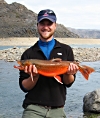
Telephone: (418) 656-2131 #408455
Dispersal, migratory behaviour, gene flow and local adaptation in Arctic char (Salvelinus alpinus) from the Canadian Arctic
Louis Bernatchez (Supervisor)
Ross Tallman (Co-supervisor)
Aaron Fisk (Co-supervisor)
I am interested in evolutionary biology and molecular ecology and in their applications in the management and conservation of wild fish populations. Most of my recent research has focused on anadromous Arctic char, a species of great importance to the Inuit people of Nunavut for subsistence and commercial harvests.
For my recent PhD work, I used mainly microsatellite markers to describe patterns of dispersal and gene flow among anadromous populations of char. Our work suggested that dispersal among populations was high, but power to assign individuals to their population of origin was limited due to the lack of genetic differentiation among populations. I also explored the recent evolutionary history of Arctic char and found phylogeographic evidence suggesting the species survived the last glaciation in a small high Arctic refugium.
For my postdoc (started in January 2013), I will re-visit similar questions using Next Generation Sequencing (NGS) tools. The possibility to rapidly identify thousands of SNPs should allow to greatly increase our power of assignment and identification of dispersers. We are also hoping that it will allow the identification of regions of the genome that differ among populations which may provide evidence for local adaptation. In addition, I am part of the Ocean Tracking Network, a large network of university researchers across Canada that use acoustic telemetry to study the migratory behaviour of dozens of marine species. This work in done in close collaboration with Dr. Ross Tallman from Fisheries and Oceans Canada, and Dr. Aaron Fisk from the University of Windsor. The possibility to combine fine-scale movement data from acoustic telemetry with a precise population assignment approach using NGS technology will allow to answer many outstanding questions regarding the migratory behaviour of Arctic char, thus allowing to develop management strategies that better reflect the complex biology of the species.